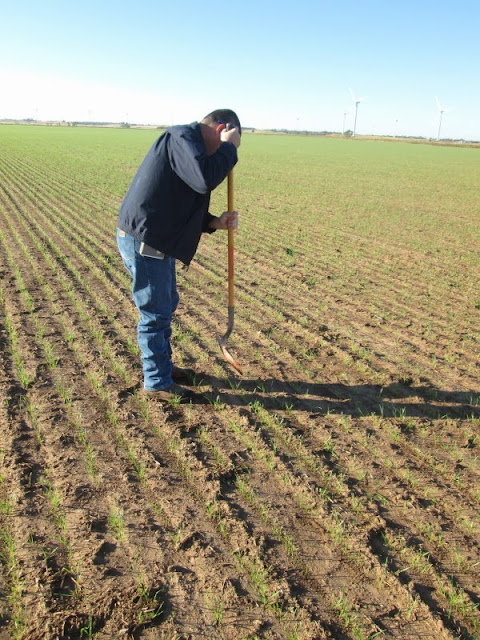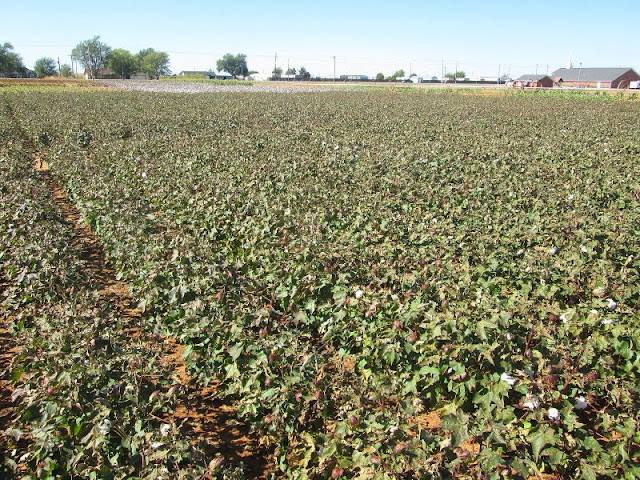So this week I made my way to Oklahoma for some research and field support activities. On Wednesday I met up with Area Manager Todd Woods and Regional Sales Manager Sean in Okarche, which is South of Kingfisher, which is West of Guthrie, which is South and West of Stillwater, where I used to live. Anyway, we met up with a wheat grower who had some winter wheat with some different drill-applied liquid fertilizers next to each other in a field. Below we see them on the edge of the field, with the windmill generators in the background. There are a lot of them around here and they were really blowing that day. I kept losing my hat. We had to act fast.
Part of the field had received 8 gal/A of 6-24-6 fertilizer, part had no fertilizer, and part had 4 gal/A of Pro-Germinator + 1 qt/A + 3.75 gal/A of 28%. This would keep the total rate at 8 gal/A which is what the drill was set to apply. One thing that we look for on small crops is root development. Here we see Todd digging up some plants. He did it at the same distance from the edge for all three treatment comparisons.
Here is what we found. It wasn't obvious just looking out into the field, but when cleaned of soil and laid side by side, there were obvious differences. The wheat with the Pro-Germinator had the biggest roots and were taller as well. They also appeared to be greener, but that may have just been my biased vision. The grower was kind of stand-offish when we got there, but really perked up when he saw this. Now of course the yields will be the true test, but I like to see these early differences to help explain potential differences in the future. Hopefully that is.
We looked at some of his other fields that had the Agro-Liquid fertilizer, and also with big hairy roots. Hey, that's what I live for. On the edge of one field were some round bales of hay. What kind of hay you ask? Crabgrass hay. Now I grew up around here, but had not really been familiar with crabgrass as a forage crop. But it's one weed that has a decent use, and the quality of crabgrass as a forage is actually pretty good. I guess nutsedge hay never really made it though.
Later that day I stopped by Hinton where we have some contract research plots. The grain sorghum plots had been recently harvested so I will get those results soon. Here are the cotton plots. This was kind of planted late due to wet weather, and there was not much open bolls. But they had sprayed boll opener (Ethephon plant growth regulator) on it the other day.
Then I met up with Area sales manager Parker Christian over by Cordell. Here is Parker in a field of cotton that received 4 gal/A of Pro-Germinator + 1 qt/A of Micro 500 at planting. It looks good this year thanks to decent rain this summer.
This field had that planter application, and it is full of bolls. I will be anxious to see how this yields.
Here is a field of wheat nearby that had 4 gal/A of Pro-Germinator + 1 qt/A of Micro 500 + 2 gal/A of High NRG-N. This wheat looks good and also had the big hairy roots that we like to see.
Parker is a good crop scout and checks this field of wheat on wheat for pests like wheat mites. They got the all clear today.
So that was fun. The weather is nice and the wheat should really grow fast with good soil moisture and Liquid fertilizer. But my mission is not over yet.








